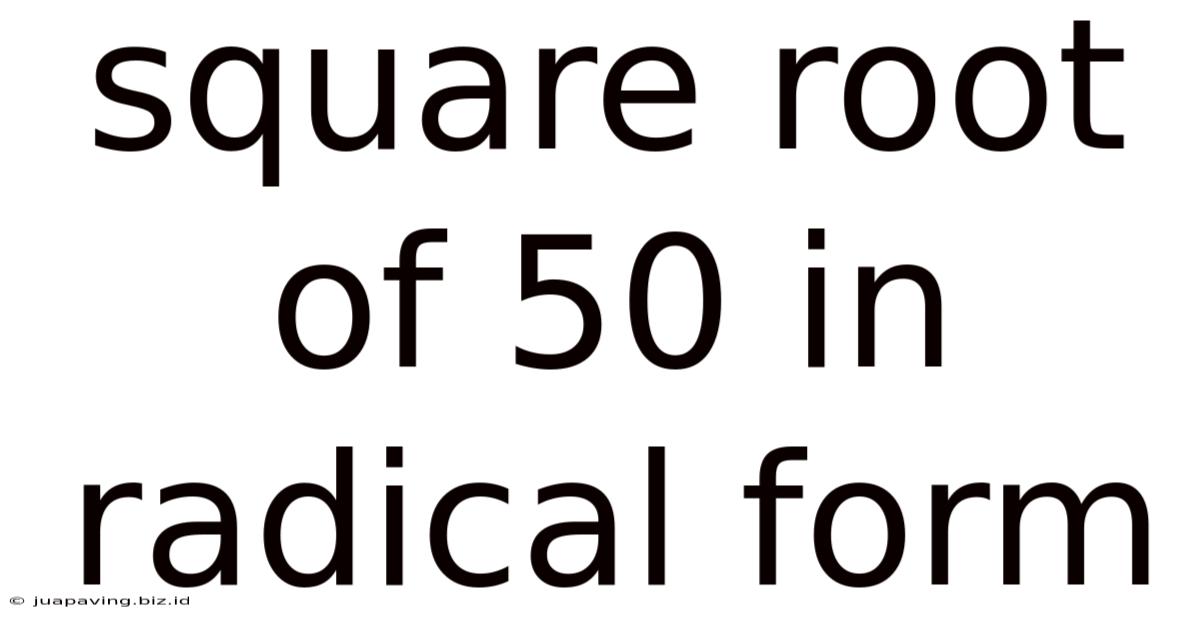Square Root Of 50 In Radical Form
Juapaving
May 13, 2025 · 4 min read

Table of Contents
Understanding the Square Root of 50 in Radical Form
The square root of 50, denoted as √50, is an irrational number, meaning it cannot be expressed as a simple fraction. However, we can simplify it into a more manageable radical form. This process involves finding the prime factorization of the number under the radical and then extracting perfect squares. This article will delve deep into understanding and simplifying √50, exploring related concepts, and offering practical examples. We'll also touch upon the broader implications of simplifying radicals in mathematics and beyond.
Prime Factorization: The Key to Simplification
The foundation of simplifying radicals lies in prime factorization. Prime factorization is the process of breaking down a number into its prime factors – numbers divisible only by 1 and themselves. For 50, we can perform the following factorization:
50 = 2 × 25 = 2 × 5 × 5 = 2 × 5²
This factorization reveals that 50 contains a perfect square: 5². This is crucial for simplifying the square root.
Simplifying √50
Now that we've found the prime factorization of 50 (2 × 5²), we can simplify the square root:
√50 = √(2 × 5²) = √2 × √5²
Since √5² = 5 (the square root of a square is the original number), we get:
√50 = 5√2
Therefore, the simplified radical form of √50 is 5√2. This is the most concise and mathematically correct representation.
Why Simplify Radicals?
Simplifying radicals, such as reducing √50 to 5√2, offers several advantages:
-
Clarity and Precision: Simplified radicals provide a clearer and more precise representation of the number. 5√2 is more informative and easily understood than √50.
-
Easier Calculations: Simplified radicals make calculations involving square roots significantly easier. For example, adding or subtracting radicals requires them to be in their simplest form.
-
Mathematical Consistency: Simplifying radicals adheres to mathematical conventions and ensures consistency in calculations and presentations.
Approximating √50 and 5√2
While 5√2 is the exact radical form, we might need an approximate decimal value in practical applications. Using a calculator, we can find that:
√50 ≈ 7.071
And for 5√2:
5√2 ≈ 7.071
As you can see, both expressions yield the same approximate decimal value, confirming the accuracy of our simplification.
Working with Other Radicals
The process of simplifying radicals is applicable to any radical expression. Let's consider a few examples:
-
√72: The prime factorization of 72 is 2³ × 3². This allows simplification to √(2² × 2 × 3²) = 6√2.
-
√125: The prime factorization of 125 is 5³. This simplifies to √(5² × 5) = 5√5.
-
√196: Since 196 is a perfect square (14²), √196 simplifies to 14 directly. There is no radical left in this case.
These examples highlight the universality of the prime factorization method in simplifying radical expressions.
Advanced Concepts and Applications
Simplifying radicals extends beyond basic arithmetic. It plays a crucial role in various mathematical fields and applications:
-
Algebra: Simplifying radicals is essential for solving algebraic equations involving square roots.
-
Geometry: Calculating distances, areas, and volumes often involves simplifying radical expressions. Think of using the Pythagorean theorem – the result might involve a radical that needs simplification.
-
Calculus: Derivatives and integrals often result in expressions containing radicals, which require simplification for further calculations.
-
Physics and Engineering: Many physical laws and engineering formulas involve square roots, necessitating radical simplification for accurate calculations.
Mistakes to Avoid When Simplifying Radicals
While simplifying radicals is straightforward, some common mistakes can lead to incorrect results. Be aware of these potential pitfalls:
-
Incorrect Prime Factorization: An error in identifying the prime factors of the number under the radical will lead to an incorrect simplification.
-
Incorrect Extraction of Perfect Squares: Failing to correctly identify and extract all perfect squares from the radical results in an incomplete simplification.
-
Misunderstanding of Radical Rules: Applying incorrect rules for multiplying or dividing radicals will give wrong answers.
Always double-check your work to ensure accuracy and avoid these errors.
The Importance of Practicing Radical Simplification
Mastering radical simplification requires consistent practice. The more you practice, the more confident and accurate you will become in simplifying various radical expressions. Start with simple examples and gradually increase the complexity to build your skills. Remember to always double-check your work using a calculator to verify your answers.
Conclusion: √50 and the Power of Simplification
Simplifying the square root of 50 to 5√2 is more than just a mathematical operation; it's a demonstration of fundamental mathematical principles. Understanding prime factorization and applying the rules of radicals are essential skills for anyone pursuing further studies in mathematics or related fields. The simplification process enhances clarity, facilitates calculations, and ensures mathematical accuracy, proving invaluable in various contexts from basic arithmetic to advanced applications in science and engineering. Consistent practice and attention to detail will solidify your understanding and mastery of this essential mathematical concept.
Latest Posts
Latest Posts
-
Number Of Valence Electrons For Potassium
May 13, 2025
-
Derivative Of X 3 X 1
May 13, 2025
-
Homologous Chromosomes Vs Non Homologous Chromosomes
May 13, 2025
-
Is Specific Heat Capacity Intensive Or Extensive
May 13, 2025
-
The Substance That Is Dissolved In The Solution
May 13, 2025
Related Post
Thank you for visiting our website which covers about Square Root Of 50 In Radical Form . We hope the information provided has been useful to you. Feel free to contact us if you have any questions or need further assistance. See you next time and don't miss to bookmark.